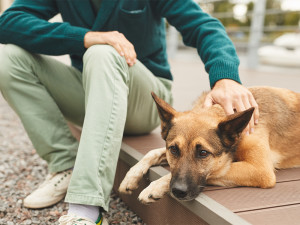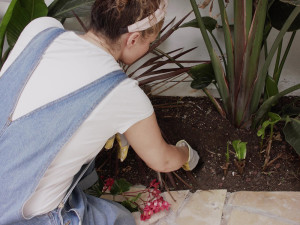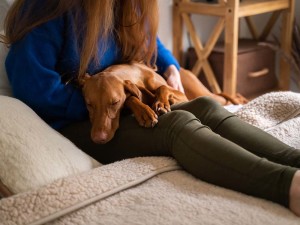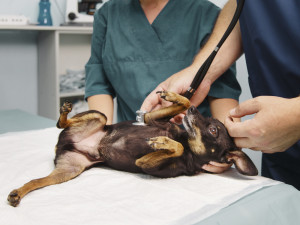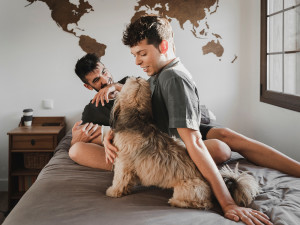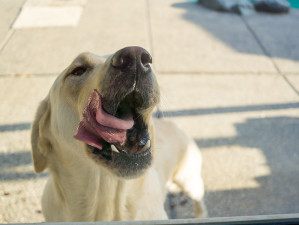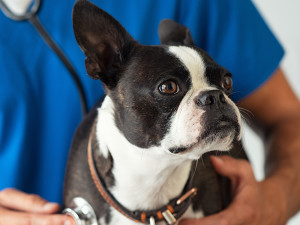The Facts of Poop: How to Treat Your Dog’s Diarrhea
Shudder. It happens to all of us.

share article

Your pet wants you to read our newsletter. (Then give them a treat.)
Dog diarrhea: We don’t want to talk about it. We don’t want to look at it. We definitely don’t want to touch it. Our dogs’ diarrhea is definitely not the most adorable thing about them, but s*it happens. As much as we don’t want to, we have to deal with it.
What is dog diarrhea?
Dog diarrhea is probably the most common complaint received by veterinarians. It’s such an easy condition to identify (the smell, the texture, you get it). Minor gastrointestinal problems are common and can be treated at home safely and effectively. At the same time, there are dogs whose stomach problems, if not addressed early enough by a veterinary professional, suffer more than they need to. Find out the causes of dog diarrhea, how to stop it, when you should be worried, and how to help your dog feel better fast.
What are the common causes of diarrhea in dogs?
Diarrhea is not a disease; it is a symptom of a dysfunction of the gastrointestinal tract (GIT). In simple terms, diarrhea in dogs is caused by something that hinders the intestine’s ability to absorb or secrete water. Here are some of the causes of diarrhea in dogs:
When associated with bad food or food-borne pathogens, diarrhea serves to rapidly remove pathogens from the GIT before they have a chance to be absorbed and cause more damage.
Occasional diarrhea is to be expected in dogs. Mild bouts of diarrhea will often resolve within two to four days on their own or with simple home remedies (see below).
Most of the time, diarrhea is caused by dietary indiscretion (eating too many treats, garbage, or table scraps) or stressful circumstances and is self-resolving.
Other common causes of diarrhea in dogs may include allergies,opens in a new tab viral infections, inflammatory bowel disease, ingestion of toxins, parasitesopens in a new tab, pancreatitisopens in a new tab, colitis, or other illnesses.
When to Visit Your Veterinarian For Diarrhea in Dogs
Warning signs that your dog’s diarrhea needs medical attention include:
Black, tarry stool, or stool with copious amounts of fresh bloodopens in a new tab (bright red)
Loss of appetiteopens in a new tab
Marked lethargy
Frequent vomitingopens in a new tab
Signs of abdominal pain, avoidance response when the belly is touchedopens in a new tab
Bloating, groaning, or panting rapidly
Lasts longer than 48 hours. Because it can rapidly weaken puppies and geriatrics, or dogs with chronic diseases, they may need veterinary attention sooner.
When it comes to diagnosing the cause of diarrhea, the color and consistency of your dog’s poop actually says a lot about their healthopens in a new tab. Take note of the color and consistency of their stool and any other symptoms your dog is experiencing. This information will help your vet determine what’s going on with your pup and get them back to normal.
How can I treat mild cases of diarrhea at home?
When your normally healthy dog has mild diarrhea and doesn’t meet any of the above criteria, it is best to start with some simple dog diarrhea home remedies. To help your pup avoid dehydrationopens in a new tab, give your pup access to water and put your dog on a 24-hour rice-water fast (white rice balls that contain active probiotic cultures), then follow up with a bland diet based on white rice.
Making Rice Water
One of the best dog diarrhea home remedies is rice water: Fasting your dog allows their GIT to rest and recover from whatever irritation it has received. During the fast, make sure your dog has plenty of rice water to drink. (Rice water is the creamy liquid that results from boiling white rice in water.) It’s important to use a good quality white rice; “minute” rice does not work and brown riceopens in a new tab has too much fiber in it, which does not help firm the stool because it speeds up how fast digested material moves through the colon.
To make rice water, boil one cup of white rice in four cups of water for 10 minutes or until the water turns creamy white. Keep the lid slightly uncovered. Strain the liquid and allow it to cool. You can serve the rice water to your dog as often as they will drink it. If they aren’t interested, mix a teaspoon of chicken baby food (or another flavor that your pet likes) in the rice water to increase palatability. (Heads up: One cup of white rice makes a lot of rice water!)
Adding Probiotics
Another great dog diarrhea home remedy is to introduce probiotics fo their diet: Probioticsopens in a new tab are living bacterial cultures intended to assist the body’s naturally occurring gut flora in reestablishing themselves — they may also help speed recovery. These live microorganisms are found in yogurt and are also available from health food stores or your veterinarian as high-potency powdered acidophilus cultures, which are more effective than yogurt for diarrhea. Mix these cultures into the rice water that you are serving your pet during their fast.
As you reintroduce solids, continue to add probiotics to your pup’s food. Use at least two to 10 billion viable bacterial organisms in each meal you serve; to determine the level of “viable organisms” or “colony forming units” (CFUs) present in a probiotic such as acidophilus, look on the label — a reputable manufacturer will list that number.
Reintroduce Solids Slowly
When it comes to dog diarrhea home remedies, feeding your pup a home-cooked bland diet can be beneficial as you reintroduce solids. After the fast is over, start your dog back on a diet of white rice cooked with extra water and mixed with small amounts of baby food for protein and flavor. To make white rice, use two to three cups of water for each cup of dry rice.
Beyond rice, other simple foods that can help relieve your dog’s diarrhea include pumpkinopens in a new tab, cottage cheese, peeled boiled potatoes and plain chicken breast. Remember, this bland diet is not balanced, so do not feed it to your dog for more than a few days.
Can I give over-the-counter medications to my dog for diarrhea?
When it comes to dog medicine for diarrhea, your veterinarian may recommend the oral administration of an intestinal protectant, such as kaolin clay and pectin (KaoPectate™), or a suspension containing bismuth subsalicylate (PeptoBismol™). The antidiarrheal loperamide (Imodium™) can be given if the diarrhea doesn’t resolve easily but administer for no more than five days. Always confirm the correct dose and best use of these medications with your veterinarian. There are several instances would you should not use these medications:
Caution is required when using over-the-counter medications in Collies, Shelties, and Australian Shepherds because of a possible genetic mutation.
They are not recommended for puppies, seniors, or dogs with other health conditions, such as liver or kidney diseaseopens in a new tab.
While dogs can tolerate PeptoBismol or KaoPectate, these medications should never be given to cats, as they contain salicylates, which are potentially toxic for felines.
Dosages for the two intestinal protectants mentioned above are approximate (call your vet to confirm). Use the liquid medication, not the tablets, and give about 1 cc of liquid for every 10 pounds of body weight up to three times daily. The bismuth subsalicylate has more anti-inflammatory activity, so it may work better on patients with abdominal cramping.
If your dog’s diarrhea is severe, your veterinarian may want you to also give them some loperamide (Imodium AD™). This can help to reduce fluid loss until the rice-water fast, white rice and acidophilus, and the dog’s own healing system can overcome the diarrhea. The published dose for loperamide in dogs is 2 milligrams (the standard-size capsule) for every 40 to 45 pounds of body weight, two to three times daily (this translates into no more than 0.1 milligram per pound).
This information is not meant to be a substitute for veterinary care. Always follow the instructions provided by your veterinarian.
FAQ (People Also Ask)
1) How is diarrhea diagnosed in dogs?
Diarrhea in dogs is diagnosed by answering a series of questions including the consistency of the poop, color, frequency, and whether there is blood.
2) How do you prevent diarrhea in dogs?
Probiotics can be used to naturally prevent diarrhea in dogs — make sure they contain at least two of these strains: S. boulardii and B. subtilis should be at least one billion CFU.
3) What are the warning signs of diarrhea in dogs?
The number one warning sign of diarrhea in dogs is loose stools — if it’s watery and soft, and more frequent than normal. Other signs include lethargy and vomiting.
References
Robert J. Silver, DVM
Robert Silver, DVM, founder of Boulder's Natural Animal: A Holistic Wellness Center, is also a certified veterinary acupuncturist. He received his DVM from Colorado State University's College of Veterinary Medicine in 1982.
Related articles
![A dog sitting on the floor with a bowl of kibble.]() opens in a new tab
opens in a new tabEverything You Need to Know About Your Dog’s Gut Microbiome
Microscopic organisms may reveal pathways to better health for your pet.
![Same sex couple with their dog lying on the bed laughing at his farts]() opens in a new tab
opens in a new tabWhy Do Dogs Fart? Causes and Remedies for Dog Flatulence
Expert solutions for your pup’s unfortunate flatulence.
![Labrador retriever licking their lips]() opens in a new tab
opens in a new tabWhy Do Dogs Eat Poop?
What to do when your dog has questionable tastes.
![French bulldog being examined at the vet via stethoscope]() opens in a new tab
opens in a new tab9 Tips For Saving Money At the Vet
Ways to lower your bill — without compromising your pet’s health.
![A woman in a bright yellow-orange sweater holding a striped kitten in one hand and a credit card in the other while using her laptop in front of her]() opens in a new tab
opens in a new tabCan’t Pay Your Pet’s Vet Bills? These Orgs Can Help
When the bills rack up, these resources have your back.
![bandaging dog's bleeding paw]() opens in a new tab
opens in a new tabHow to Care for Your Bleeding Dog
Don’t freak out—here’s what to do.


